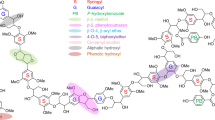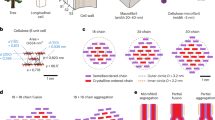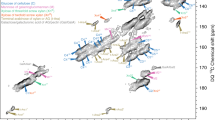Abstract
Recent advances in nuclear magnetic resonance (NMR) technology have made it possible to rapidly screen plant material and discern whole cell wall information without the need to deconstruct and fractionate the plant cell wall. This approach can be used to improve our understanding of the biology of cell wall structure and biosynthesis, and as a tool to select plant material for the most appropriate industrial applications. This is particularly true in an era when renewable materials are vital to the emerging bio-based economies. This protocol describes procedures for (i) the preparation and extraction of a biological plant tissue, (ii) solubilization strategies for plant material of varying composition and (iii) 2D NMR acquisition (for typically 15 min–5 h) and integration methods used to elucidate lignin subunit composition and lignin interunit linkage distribution, as well as cell wall polysaccharide profiling. Furthermore, we present data that demonstrate the utility of this new NMR whole cell wall characterization procedure with a variety of degradative methods traditionally used for cell wall compositional analysis.
This is a preview of subscription content, access via your institution
Access options
Subscribe to this journal
Receive 12 print issues and online access
$259.00 per year
only $21.58 per issue
Buy this article
- Purchase on Springer Link
- Instant access to full article PDF
Prices may be subject to local taxes which are calculated during checkout



Similar content being viewed by others
References
Weng, J.K. & Chapple, C. The origin and evolution of lignin biosynthesis. New Phytologist. 187, 273–285 (2010).
Vanholme, R., Morreel, K., Ralph, J. & Boerjan, W. Lignin biosynthesis and structure. Plant Physiol. 153, 895–905 (2010).
Ralph, J. et al. Lignins: natural polymers from oxidative coupling of 4-hydroxyphenylpropanoids. Phytochem. Revs. 3, 29–60 (2004).
Boerjan, W., Ralph, J. & Baucher, M. Lignin biosynthesis. Annu. Rev. Plant Biol. 54, 519–549 (2003).
Sarkanen, K.V. & Ludwig, C.H. Lignins, Occurrence, Formation, Structure and Reactions (Wiley-Interscience, 1971).
Freudenberg, K. & Neish, A.C. Constitution and Biosynthesis of Lignin (Springer-Verlag, 1968).
Ralph, J. & Landucci, L.L. NMR of lignins. in Lignin and Lignans; Advances in Chemistry (eds. Heitner, C., Dimmel, D.R. & Schmidt, J.A.) 137–234 (CRC Press, 2010).
Ralph, J. Hydroxycinnamates in lignification. Phytochem. Revs. 9, 65–83 (2010).
Vanholme, R., Morreel, K., Ralph, J. & Boerjan, W. Lignin engineering. Curr. Opin. Plant Biol. 11, 278–285 (2008).
Ralph, J. et al. in Recent Advances in Polyphenol Research Vol. 1 (eds. Daayf, F., El Hadrami, A., Adam, L. & Balance, G.M.) Ch. 2, 36–66 (Wiley-Blackwell Publishing, 2008).
Ralph, J. Perturbing lignification. in The Compromised Wood Workshop 2007 (eds. Entwistle, K., Harris, P.J. & Walker, J.) 85–112 (Wood Technology Research Centre, University of Canterbury, 2007).
Ralph, J. et al. Peroxidase-dependent cross-linking reactions of p-hydroxycinnamates in plant cell walls. Phytochem. Revs. 3, 79–96 (2004).
Ralph, J. et al. Cell wall cross-linking in grasses by ferulates and diferulates. et al. in Lignin and Lignan Biosynthesis, Vol. 697. (eds. Lewis, N.G. & Sarkanen, S.) 209–236 (American Chemical Society, 1998).
Jung, H.G. & Allen, M.S. Characteristics of plant cell walls affecting intake and digestibility of forages by ruminants. J. Animal Sci. 73, 2774–2790 (1995).
Jung, H.G. Forage lignins and their effects on fiber digestibility. Agron. J. 81, 33–38 (1989).
Stewart, J.J., Kadla, J.F. & Mansfield, S.D. The influence of lignin chemistry and ultrastructure on the pulping efficiency of clonal aspen (Populus tremuloides Michx.) Holzforschung 60, 111–122 (2006).
Chen, F. & Dixon, R.A. Genetic manipulation of lignin biosynthesis to improve biomass characteristics for agro-industrial processes. In Vitro Cell. Dev. Biol.—Animal 44, S28–S29 (2008).
Li, X., Weng, J.K. & Chapple, C. Improvement of biomass through lignin modification. Plant J. 54, 569–581 (2008).
Chapple, C., Ladisch, M. & Meilan, R. Loosening lignin's grip on biofuel production. Nat. Biotechnol. 25, 746–748 (2007).
Bonawitz, N.D. & Chapple, C. The genetics of lignin biosynthesis: connecting genotype to phenotype. Annu. Rev. Genet. 44, 337–363 (2010).
Simmons, B.A., Loqué, D. & Ralph, J. Advances in modifying lignin for enhanced biofuel production. Curr. Opin. Plant Biol. 13, 313–320 (2010).
Jouanin, L. et al. Comparison of the consequences on lignin content and structure of COMT and CAD downregulation in poplar and Arabidobsis thaliana. in Plantation Forest Biotechnology in the 21st Century (eds. Walter, C. & Carson, M.) 219–229 (Research Signpost, 2004).
Boerjan, W. et al. in Molecular Breeding of Woody Plants, Vol. Progress in Biotechnology Series, Vol. 18 (eds. Morohoshi, N. & Komamine, A.), Ch. 23, 187–194 (Elsevier Science, 2001).
Mansfield, S.D. Solutions for dissolution-engineering cell walls for deconstruction. Curr. Opin. Biotechnol. 20, 286–294 (2009).
Lin, S.Y. & Dence, C.W. Methods in Lignin Chemistry (Springer-Verlag, 1992).
Lapierre, C. Application of new methods for the investigation of lignin structure. in Forage Cell Wall Structure and Digestibility (eds. Jung, H.G., Buxton, D.R., Hatfield, R.D. & Ralph, J.) 133–166 (American Society of Agronomy, Crop Science Society of America, Soil Science Society of America, 1993).
Rolando, C., Monties, B. & Lapierre, C. Thioacidolysis. in Methods in Lignin Chemistry (eds. Dence, C.W. & Lin, S.Y.) 334–349 (Springer-Verlag, 1992).
Robinson, A.R. & Mansfield, S.D. Rapid analysis of poplar lignin monomer composition by a streamlined thioacidolysis procedure and near-infrared reflectance-based prediction modeling. Plant J. 58, 706–714 (2009).
Yamamura, M., Hattori, T., Suzuki, S., Shibata, D. & Umezawa, T. Microscale alkaline nitrobenzene oxidation method for high-throughput determination of lignin aromatic components. Plant Biotechnol. 27, 305–310 (2010).
Villar, J.C., Caperos, A. & GarciaOchoa, F. Oxidation of hardwood kraft-lignin to phenolic derivatives. Nitrobenzene and copper oxide as oxidants. J. Wood Chem. Technol. 17, 259–285 (1997).
Lu, F. & Ralph, J. Efficient ether cleavage in lignins: the derivatization followed by reductive cleavage procedure as a basis for new analytical methods. in Lignin and Lignan Biosynthesis (eds. Lewis, N.G. & Sarkanen, S.) 294–322 (American Chemical Society, 1998).
Lu, F. & Ralph, J. Derivatization followed by reductive cleavage (DFRC method), a new method for lignin analysis: protocol for analysis of DFRC monomers. J. Agr. Food Chem. 45, 2590–2592 (1997).
Lu, F. & Ralph, J. The DFRC method for lignin analysis. Part 1. A new method for β-aryl ether cleavage: lignin model studies. J. Agr. Food Chem. 45, 4655–4660 (1997).
Morrison, I.M. Improvements in the acetyl bromide technique to determine lignin and digestibility and its application to legumes. J. Sci. Food Agr. 23, 1463–1469 (1972).
Morrison, I.M. Semimicro method for the determination of lignin and its use in predicting the digestibility of forage crops. J. Sci. Food Agr. 23, 455–463 (1972).
Fukushima, R.S. & Hatfield, R. Comparison of the acetyl bromide spectrophotometric method with other analytical lignin methods for determining lignin concentration in forage samples. J. Agr. Food Chem. 52, 3713–3720 (2004).
Fukushima, R.S. & Hatfield, R.D. Extraction and isolation of lignin for utilization as a standard to determine lignin concentration using the acetyl bromide spectrophotometric method. J. Agr. Food Chem. 49, 3133–3139 (2001).
Yelle, D.J., Wei, D., Ralph, J. & Hammel, K.E. Multidimensional NMR analysis reveals truncated lignin structures in wood decayed by the brown rot basidiomycete Postia placenta. Appl. Environ. Microbiol. 13, 1091–1100 (2011).
Rencoret, J. et al. Lignin composition and structure in young versus adult Eucalyptus globulus plants. Plant Physiol. 155, 667–682 (2011).
Lu, F. & Ralph, J. Solution-state NMR of lignocellulosic biomass. J. Biobased Mater. Bio. 5, 169–180 (2011).
Kim, H. & Ralph, J. Solution-state 2D NMR of ball-milled plant cell wall gels in DMSO-d6/pyridine-d5 . Org. Biomol. Chem. 8, 576–591 (2010).
Hedenström, M. et al. Identification of lignin and polysaccharide modifications in Populus pood by chemometric analysis of 2D NMR spectra from dissolved cell walls. Mol. Plant 2, 933–942 (2009).
Yelle, D.J., Ralph, J. & Frihart, C.R. Characterization of non-derivatized plant cell walls using high-resolution solution-state NMR spectroscopy. Magn. Reson. Chem. 46, 508–517 (2008).
Kim, H., Ralph, J. & Akiyama, T. Solution-state 2D NMR of ball-milled plant cell wall gels in DMSO-d6 . BioEnergy Res. 1, 56–66 (2008).
Ralph, J. & Lu, F. Cryoprobe 3D NMR of acetylated ball-milled pine cell walls. Org. Biomol. Chem. 2, 2714–2715 (2004).
Lu, F. & Ralph, J. Non-degradative dissolution and acetylation of ball-milled plant cell walls; high-resolution solution-state NMR. Plant J. 35, 535–544 (2003).
Ralph, J. et al. Solution-state NMR of lignins. in Advances in Lignocellulosics Characterization (ed. Argyropoulos, D.S.) 55–108 (TAPPI Press, 1999).
Bradley, S.A. & Krishnamurthy, K. A modified CRISIS-HSQC for band-selective IMPRESS. Magn. Reson. Chem. 43, 117–123 (2005).
Boyer, R.D., Johnson, R. & Krishnamurthy, K. Compensation of refocusing inefficiency with synchronized inversion sweep (CRISIS) in multiplicity-edited HSQC. J. Magn. Reson. 165, 253–259 (2003).
Zhang, S.M., Wu, J. & Gorenstein, D.G. 'Double-WURST' decoupling for N-15- and C-13-double-labeled proteins in a high magnetic field. J. Magn. Reson. Series A 123, 181–187 (1996).
Kupce, E. & Freeman, R. Compensation for spin-spin coupling effects during adiabatic pulses. J. Magn. Reson. 127, 36–48 (1997).
Ralph, S.A., Landucci, L.L. & Ralph, J. NMR Database of Lignin and Cell Wall Model Compounds. http://ars.usda.gov/Services/docs.htm?docid=10491 (2004).
Brennan, M., McLean, J.P., Altaner, C., Ralph, J. & Harris, P.J. Cellulose microfibril angles and cell-wall polymers in different wood types of Pinus radiata. Cellulose 19, 1385–1404 (2012).
Weng, J.-K., Akiyama, T., Ralph, J., Golden, B.L. & Chapple, C. Independent recruitment of an O-methyltransferase for syringyl lignin biosynthesis in Selaginella moellendorffii. Plant Cell 23, 2708–2724 (2011).
Weng, J.-K. et al. Convergent evolution of syringyl lignin biosynthesis via distinct pathways in the lycophyte Selaginella and flowering plants. Plant Cell 22, 1033–1045 (2010).
Vanholme, R. et al. Engineering traditional monolignols out of lignins by concomitant up-regulation F5H1 and down-regulation of COMT in Arabidopsis. Plant J. 64, 885–897 (2010).
Stewart, J.J., Akiyama, T., Chapple, C.C.S., Ralph, J. & Mansfield, S.D. The effects on lignin structure of overexpression of ferulate 5-hydroxylase in hybrid poplar. Plant Physiol. 150, 621–635 (2009).
Ralph, J. et al. Identification of the structure and origin of a thioacidolysis marker compound for ferulic acid incorporation into angiosperm lignins (and an indicator for cinnamoyl-CoA reductase deficiency). Plant J. 53, 368–379 (2008).
Leplé, J.-C. et al. Downregulation of cinnamoyl coenzyme A reductase in poplar; multiple-level phenotyping reveals effects on cell wall polymer metabolism and structure. Plant Cell 19, 3669–3691 (2007).
Ralph, J. et al. Effects of coumarate-3-hydroxylase downregulation on lignin structure. J. Biol. Chem. 281, 8843–8853 (2006).
Bunzel, M. & Ralph, J. NMR characterization of lignins isolated from fruit and vegetable insoluble dietary fiber. J. Agr. Food Chem. 54, 8352–8361 (2006).
Marita, J.M., Vermerris, W., Ralph, J. & Hatfield, R.D. Variations in the cell wall composition of maize brown midrib mutants. J. Agr. Food Chem. 51, 1313–1321 (2003).
Goujon, T. et al. A new Arabidopsis thaliana mutant deficient in the expression of O-methyltransferase impacts lignins and sinapoyl esters. Plant Mol. Biol. 51, 973–989 (2003).
Ralph, J. et al. Elucidation of new structures in lignins of CAD- and COMT-deficient plants by NMR. Phytochem. 57, 993–1003 (2001).
Marita, J., Ralph, J., Hatfield, R.D. & Chapple, C. NMR characterization of lignins in Arabidopsis altered in the activity of ferulate-5-hydroxylase. Proc. Natl. Acad. Sci. USA 96, 12328–12332 (1999).
Hu, W.-J. et al. Repression of lignin biosynthesis in transgenic trees promotes cellulose accumulation and growth. Nat. Biotechnol. 17, 808–812 (1999).
Ralph, J., Akiyama, T., Coleman, H.D. & Mansfield, S.D. Effects on lignin structure of coumarate 3-hydroxylase downregulation in Poplar. BioEnergy Research, published online, doi:10.1007/s12155-012-9218-y (24 May 2012).
Wagner, A. et al. Exploring lignification in conifers by silencing hydroxycinnamoyl-CoA:shikimate hydroxycinnamoyltransferase in Pinus radiata. Proc. Natl. Acad. Sci. USA 104, 11856–11861 (2007).
Zhang, L.M. & Gellerstedt, G. Quantitative 2D HSQC NMR determination of polymer structures by selecting suitable internal standard references. Magn. Reson. Chem. 45, 37–45 (2007).
Heikkinen, S., Toikka, M.M., Karhunen, P.T. & Kilpeläinen, I.A. Quantitative 2D HSQC (Q-HSQC) via suppression of J-dependence of polarization transfer in NMR spectroscopy: application to wood lignin. J. Am. Chem. Soc. 125, 4362–4367 (2003).
Hatfield, R.D., Marita, J.M. & Frost, K. Characterization of p-coumarate accumulation, p-coumaroyl transferase, and cell wall changes during the development of corn stems. J. Sci. Food Agr. 88, 2529–2537 (2008).
Hatfield, R.D. et al. Grass lignin acylation: p-coumaroyl transferase activity and cell wall characteristics of C3 and C4 grasses. Planta 229, 1253–1267 (2009).
Acknowledgements
We gratefully acknowledge funding from the Natural Sciences and Engineering Research Council of Canada′s Discovery Program held by S.D.M.; H.K., F.L., S.D.M. and J.R. were funded in part by the DOE Great Lakes Bioenergy Research Center (DOE Office of Science BER DE-FC02-07ER64494).
Author information
Authors and Affiliations
Contributions
S.D.M., J.R., H.K. and F.L. conceived and designed the experiments. H.K. and F.L. performed the NMR experimental evaluation. J.R. contributed to spectral interpretation. S.D.M. performed the wet chemical evaluation of the cell walls. S.D.M. and J.R. wrote the paper (with input from H.K. and F.L.).
Corresponding authors
Ethics declarations
Competing interests
The authors declare no competing financial interests.
Rights and permissions
About this article
Cite this article
Mansfield, S., Kim, H., Lu, F. et al. Whole plant cell wall characterization using solution-state 2D NMR. Nat Protoc 7, 1579–1589 (2012). https://doi.org/10.1038/nprot.2012.064
Published:
Issue Date:
DOI: https://doi.org/10.1038/nprot.2012.064
This article is cited by
-
Bioprospecting lignin biomass into environmentally friendly polymers—Applied perspective to reconcile sustainable circular bioeconomy
Biomass Conversion and Biorefinery (2024)
-
Influence of hemicellulose and lignin on intermolecular interaction between quinacridone and lignocellulosic fibers revealed by gel-state NMR and color measurements
Journal of Wood Science (2023)
-
Solution-state nuclear magnetic resonance spectroscopy of crystalline cellulosic materials using a direct dissolution ionic liquid electrolyte
Nature Protocols (2023)
-
Insights into cellulose deconstruction and pseudo-lignin formation during deep eutectic solvent treatment
Cellulose (2023)
-
Study on the quality improvement of bio-oil prepared by catalytic pyrolysis of kraft lignin: the role of micropore/mesopore beta zeolites
Biomass Conversion and Biorefinery (2023)
Comments
By submitting a comment you agree to abide by our Terms and Community Guidelines. If you find something abusive or that does not comply with our terms or guidelines please flag it as inappropriate.



